Recent Articles
Popular Makes
Body Types
2015 Toyota Prius Road Test & Review
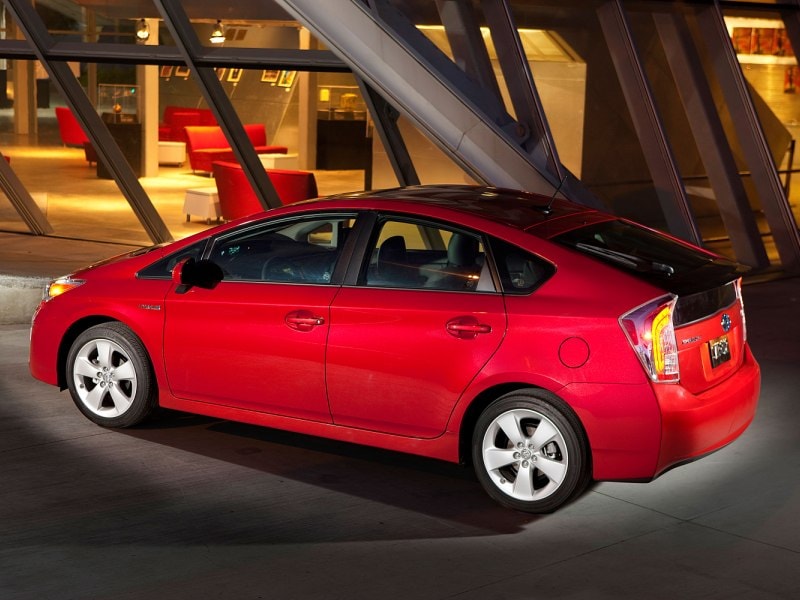
When the word “hybrid” is spoken, we’re willing to bet you envision a Toyota Prius. With its well-earned reputation as the poster child of eco-conscious motoring, the 2015 Toyota Prius is definitely top of mind when it comes to gasoline/electric hybrid automobiles; even with practically every other automaker offering such a powertrain.
Currently in its fourth generation, and accounting for more than 40 percent of the total hybrid sales volume in the US, the Toyota Prius has been around since 1997 in Japan. The model came to the States in 2000, and has since gone multi-platinum, selling in excess of four million copies. For the record, “Prius” is a Latin word meaning “to go before”. The official plural designation of the word Prius is “Prii”.
The first mass-produced gasoline-electric hybrid, a number of formidable competitors have emerged over the years. Among them are the Ford Fusion Hybrid, the plug-in Ford Fusion Energi, Volkswagen Jetta Hybrid, and the Honda Accord Hybrid. And still, the Prius rules – thanks to its exceptional fuel economy, spaciousness, reliability and ease of operation.
Models & Pricing
For the 2015 model year, Toyota is offering Prius in five trim levels as well as in two other models (the Prius V wagon, and the compact Prius c). There is also a plug-in version of the standard Prius. The trim levels are; Two, Three, Persona Series (which is new for 2015), Four, and Five.
The base model (Prius Two) starts at $24,200 and includes heated power adjustable mirrors, keyless entry and pushbutton start, a rearview camera, cruise control, automatic climate control, Bluetooth telephony and audio streaming, and a 6.1-inch touchscreen interface.
Prius Three starts at $26,895 and adds navigation, voice controls, satellite radio, and Toyota’s Entune features, which include real time traffic information, sports scores, weather, and fuel prices. Entune also leverages your smartphone to employ apps like Pandora, iHeart Radio, and Open Table.
The $28,205 Persona Series adds cosmetic touches to the Prius Three package with chrome trim, integrated turn signals in the rear view mirror housings and footwell illumination. It also replaces the cloth upholstery with leatherette.
Prius Four opens at $29,655 and adds automatic headlights, a power adjustable driver’s seat, heat for the front seats, an autodimming inside rear-view mirror, and an upgraded sound system by JBL with eight speakers.
Prius Five pricing begins at $31,255 and adds foglights, LED headlights, along with the option of the Advanced Technology package, which brings smart cruise control, pre-collision alert, lane departure warning, a head-up display, and an advanced navigation system with a seven-inch monitor and split-screen capability.
Many of these features are available as options on lower trim levels.
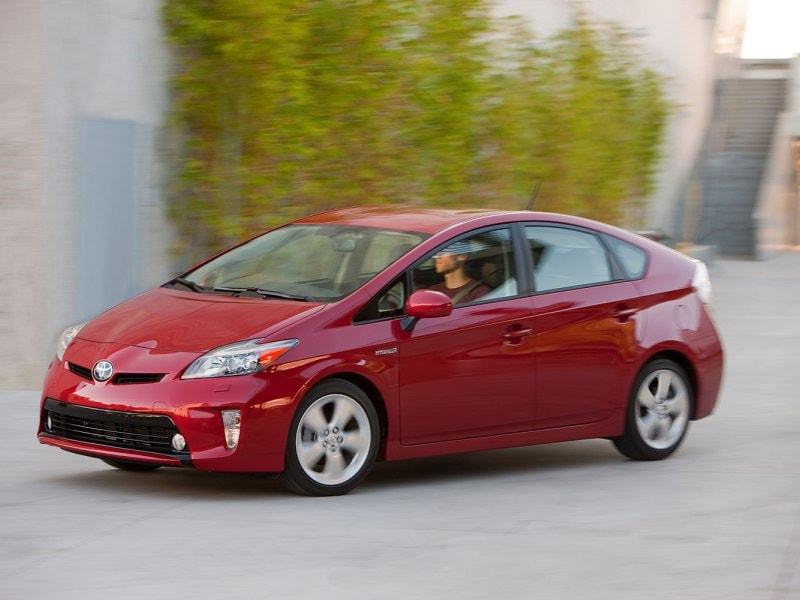
Design
The Prius enjoys a highly distinctive look. The arch-shaped auto is designed specifically to beat the wind. In fact, the hybrid Toyota boasts a drag coefficient of 0.25, which is lower than the figure for some exotic sports cars. In addition to the low nose/high tail profile, the Prius features sharp edges to help it knife through the atmosphere more efficiently.
Augmenting the super aerodynamic design is the employment of an abundance of lightweight materials. The hood, rear hatch, front stabilizer bar, and brake calipers are all crafted from aluminum. High tensile strength steel is fitted in strategic areas to improve rigidity while keeping weight to a minimum. You’ll find the material comprising the inner rocker panels, center pillars, and reinforcing the roof.
Basically, pretty much everything about the design of the Toyota Prius is calculated to reduce fuel consumption. As an example, the optional low-beam headlights, the daytime running lights and the tail lamps all use LED arrays. These consume less electricity leaving more available to power the Prius, ultimately reducing its fuel consumption.

Features & Controls
The interior of the Prius echoes the forward-thinking design of the exterior. Sleek and flowing with a host of eye-pleasing touches, the control section of the Prius looks like it came straight out of the future.
All instrumentation and secondary controls are positioned in the middle of the car. In addition to making it easier to manufacture for both right-hand and left-hand drive countries, it also places the most needed information up high so the driver can keep an eye on the road while monitoring speed, fuel level and the like.
Contained within the waterfall design of the center stack are the touchscreen for infotainment functions, as well as the climate control system and the transmission’s function selector. Conventional dials are used for adjusting the audio level and changing the station on the radio, while the other functions are relegated to a series of lookalike buttons flanking the main display. They are legibly marked, so you can usually find what you’re looking for at a glance, but they also all look alike so you’ll have to study them for a bit until you memorize the layout.
Mounted in the steering wheel are touch sensitive redundant switchgear for the audio system and the climate control system. When you interact with them, a duplicate image of the function you’ve selected is displayed on the instrument panel, so you don’t have to look down to see what you’re adjusting. You’ll find the buttons for the voice activated control system, and the handsfree telephone too.
The Prius also offers (as an option) a solar cell array in the sunroof to power the ventilation system to keep air circulating in the car when it is parked in the sun. There’s also an optional remote air conditioning system to cool the car before you enter on extremely hot days.
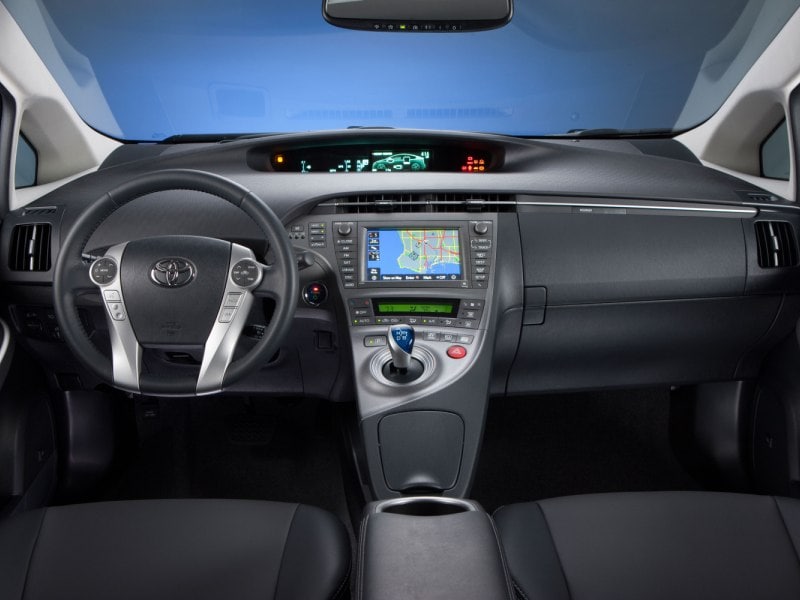
Comfort & Cargo
Which brings us to the overall comfort of the Prius.
Another benefit of that cutting-edge interior treatment is the abundance of space it gives over to the accommodation of people. Further, lest that sloping roofline and low coefficient of drag mislead you, you’ll find some 37.6 inches of rear seat headroom, and 36 inches of rear seat legroom in the Prius. This means taller people can ride along in decent comfort. Front seat occupants might have to slide forward a bit for your tallest rear-seat passengers, but overall comfort will be minimally impacted.
The seats in the base model are upholstered in cloth, so sliding around in them isn’t really an issue. However even the “leatherette” covered seats provide good support over long-ish drives. In sum, the Prius does an admirable job of transporting four people – even five in a pinch. (Toyota claims five, but trust us, two people are happier in the back seat than three.)
The hatchback design lends a great deal of utility to the car, allowing it to serve quite admirably as a stealthy hauler of stuff if the need arises. The rear seatbacks split fold in a 60:40 ratio so you can balance flexibility against cargo carrying ability. You’ll find some 21.6 cubic feet of cargo capacity with the rear seatbacks deployed. Folded, you’ll net slightly less than 40 cubic feet.
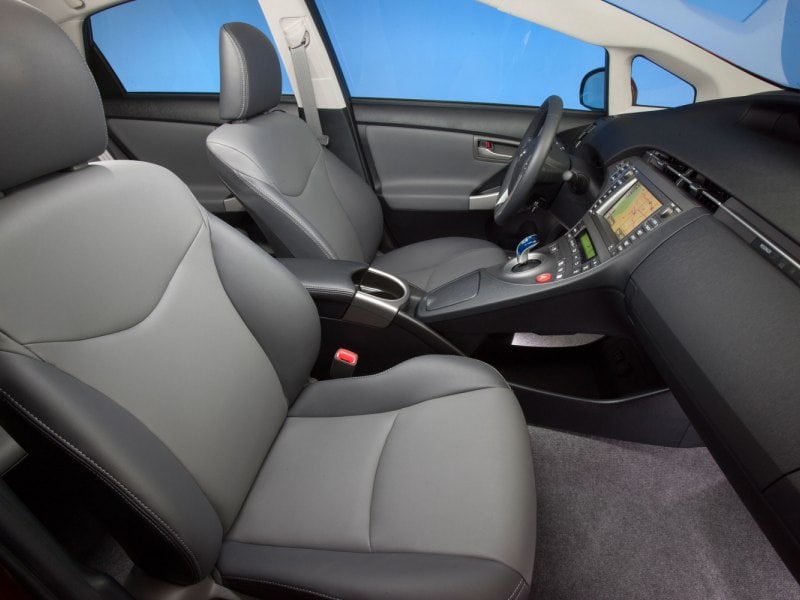
Safety Features & Ratings
The 2015 Toyota Prius features, as standard safety equipment, ABS, stability control, traction control, front seat side airbags, side curtain airbags, and of course the typical dash and steering wheel mounted bags for the front passengers. The model also features a rearview camera as standard equipment.
There are times when the Prius runs solely on electric power, so it could be difficult for pedestrians to hear the Toyota approaching. To mitigate this, the model features Toyota’s Vehicle Proximity Notification System, which emits an undulating mechanical sound to help people walking and bicycling hear the car approaching.
Optional safety features include dynamic cruise control, brake override, lane departure warning, frontal collision warning, collision notification, stolen vehicle location, as well as emergency and roadside assistance, along with pre collision prep. The pre-collision system retracts the front seatbelts and applies the brakes in certain conditions when it determines a frontal crash is unavoidable.
NHTSA says the Prius is a four star car in terms of overall crash protection. The model also earned five stars in NHTSA’s side crash testing. The Insurance Institute of Highway Safety (IIHS) pronounced the Prius “Good” (its highest rating) in moderate overlap frontal offset tests, and “Acceptable” (its second highest rating) in small overlap frontal offset testing. IIHS also rated Prius “Good” in all of the other tests; side impact, roof strength, and whiplash protection.
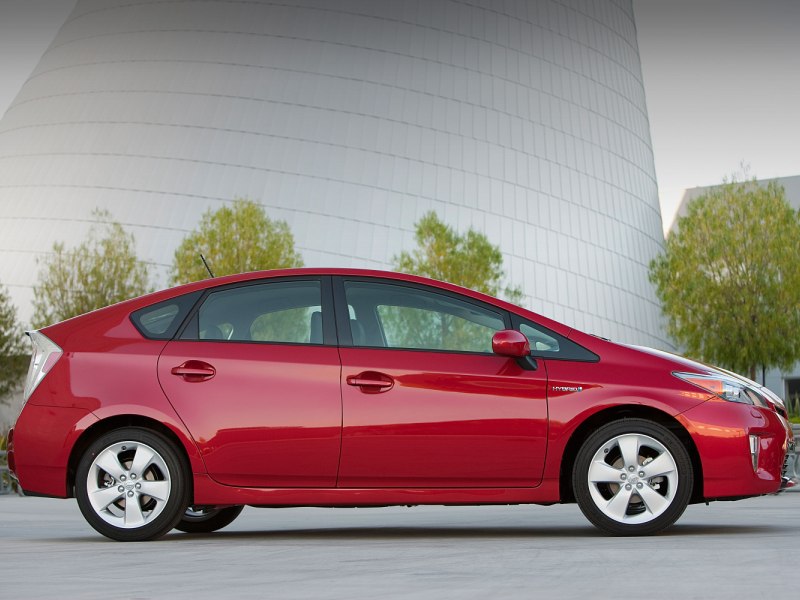
Engine & Fuel Economy
Power comes from a 1.8-liter four-cylinder engine teamed with a pair of electric motors/generators. Total system output is 134 horsepower, routed to the front wheels through a continuously variable transmission. Prius is a full hybrid, so it can run either on gasoline, or electricity, or a combination of the two.
Four driving modes are offered to tailor power output to the specific situation at hand. The modes are referred to as Normal, Power, ECO and EV. Somewhat self-explanatorily; the Normal mode provides a nice balance between performance and fuel economy. POWER mode advances the throttle's response for optimal performance. ECO mode retards throttle response and regulates climate control functions to optimize fuel economy. In EV mode, the Prius can drive on battery power alone at speeds up to 25 miles per hour for about a mile.
To further increase fuel economy, the Prius is fitted with an electric water pump and electric power steering so no energy is lost to belts and pulleys for these accessories. Exhaust heat is used to help engine coolant get up to temperature more quickly, which further reduces waste as well as enables the engine to generate fewer pollutants by warming up faster. It also heats the interior sooner on cold days.
Fuel economy is rated at 50 miles per gallon combined, 51 in the city, and 48 on the highway.
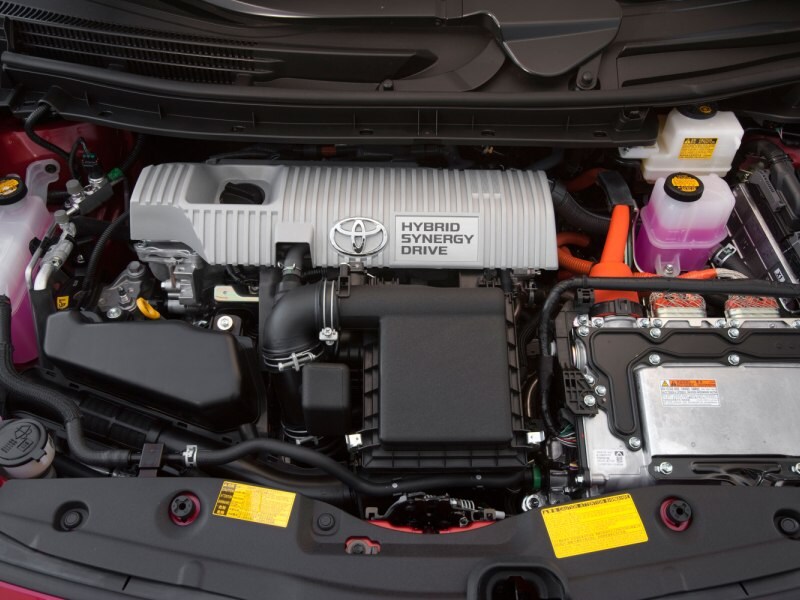
Driving Impressions
Despite all of the advanced technology, or perhaps because of all of the advanced technology, the Toyota Prius is pretty – well – normal to drive.
Steering response, braking, and cornering are about average for a family sedan biased more toward ride comfort than outright handling. It isn’t fast, but it isn’t slow either. It doesn’t handle exceptionally well, but it is competent. It isn’t exceptionally noisy, nor is it particularly quiet.
All in all, it’s a pretty mainstream situation.
The mission brief for the Prius largely reads; ”Get a driver and up to four passengers from Aaron Brothers to Bed, Bath, and Beyond as comfortably as possible, while consuming as little fuel as possible.” Happily, when it comes to fulfilling its mission, Prius has few peers.
If you’ve ever wondered why a Prius is so often the last car off the line at a traffic signal, it’s because a light throttle application keeps the car operating in the electric mode while the Toyota gets up to 25 miles per hour – if the battery is at least halfway charged.
A savvy driver can take advantage of this to decrease fuel consumption – and most of them do. Now before this leaves you thinking the Prius is slug-slow, be assured it is quick enough. In fact, set the drive mode selector to power and the little Toyota scoots away from a standing start pretty good. Still though, you’re looking at about 10 seconds to 60.
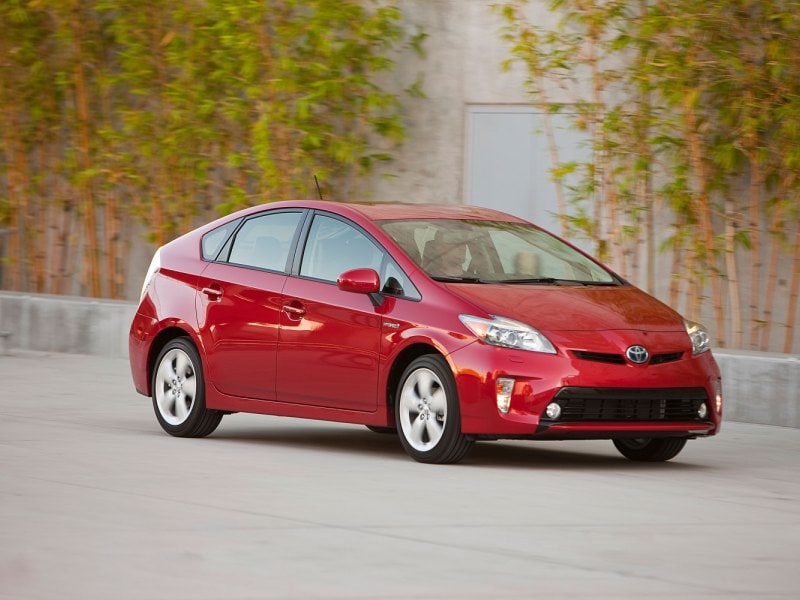
Photo by Toyota
Final Thoughts
Long story short, the reasons Toyota’s Prius has become the go-to hybrid are manifold. As far as most people are concerned it was the first hybrid, and it delivers amazing fuel economy. Further, the Prius has proven to be exceptionally reliable as well as inexpensive to operate. This, friends, is one recipe for success in mainstream motoring.
The other thing the Prius has going for it is it’s an instantly identifiable hybrid. If you want people to know you’re driving a hybrid, with Prius there’s no doubt. Most other hybrid models also have standard powertrain options. When you driving one of them it isn’t as obvious you’re doing your part to preserve the planet.
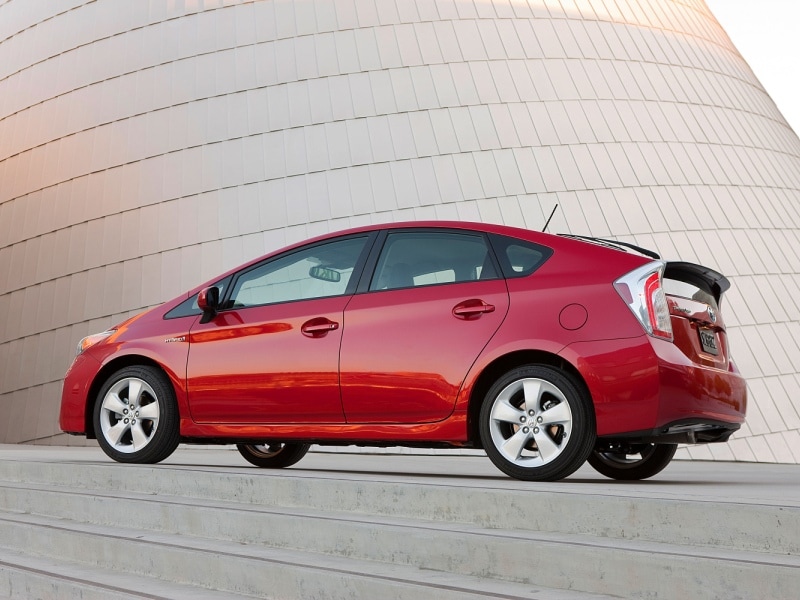
Pros & Cons
Pros: Astounding fuel economy, a strong roster of standard features, comfortably spacious interior…
Cons: Leisurely acceleration, engine can be noisy...
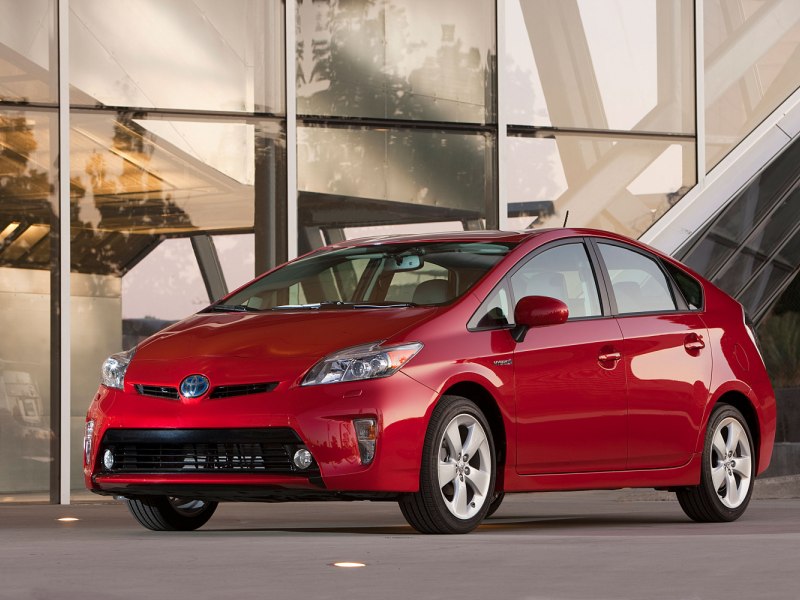
Photo by Toyota